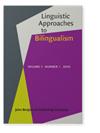变量V2在挪威传统语言
IF 1.8
2区 文学
0 LANGUAGE & LINGUISTICS
引用次数: 6
摘要
摘要本文通过对北美50位第2代至第4代传统语使用者的自发语音语料库的调查,讨论了挪威传统语中动词第二语序的可能损耗。该研究证实了之前的发现,即V2语序在遗产情况下通常是稳定的,但仍发现约10%的V2违规行为。非V2语序的情况被认为是由于缺乏对传统语言语法的激活,使其容易受到说话者主导语言的跨语言影响。这种跨语言的影响并不是简单地用非V2取代V2,而是被认为更间接地起作用,影响(a)V2语序的上下文分布,以及(b)在传统语言中引入两种新的区别,一种是(间接地)基于主导语言中的类似区别(副词和否定在动词运动方面的区别),另一个基于非主题初始声明词中触发V2的初始元素的频率。总之,这些发现还表明,跨语言影响对V2的不同语境产生了不同的影响,为将V2语序视为许多较小规则的结果的分析提供了支持。本文章由计算机程序翻译,如有差异,请以英文原文为准。
Variable V2 in Norwegian heritage language
Abstract This paper discusses possible attrition of verb second (V2) word order in Norwegian heritage language by investigating a corpus of spontaneous speech produced by 50 2nd–4th generation heritage speakers in North America. The study confirms previous findings that V2 word order is generally stable in heritage situations, but nevertheless finds approximately 10% V2 violations. The cases of non-V2 word order are argued to be due to lack of activation of the heritage language grammar, making it vulnerable to crosslinguistic influence from the speakers’ dominant language. This crosslinguistic influence does not simply replace V2 by non-V2, but is argued to operate more indirectly, affecting (a) the distribution of contexts for V2 word order, and (b) introducing two new distinctions into the heritage language, one (indirectly) based on a similar distinction in the dominant language (a difference between adverbs and negation with respect to verb movement), the other based on frequency of initial elements triggering V2 in non-subject-initial declaratives. Together, these findings also indicate that crosslinguistic influence affects different contexts of V2 differently, providing support for analyses that treat V2 word order as the result of many smaller rules.
求助全文
通过发布文献求助,成功后即可免费获取论文全文。
去求助
来源期刊

Linguistic Approaches To Bilingualism
Social Sciences-Linguistics and Language
CiteScore
3.20
自引率
9.10%
发文量
24
期刊介绍:
LAB provides an outlet for cutting-edge, contemporary studies on bilingualism. LAB assumes a broad definition of bilingualism, including: adult L2 acquisition, simultaneous child bilingualism, child L2 acquisition, adult heritage speaker competence, L1 attrition in L2/Ln environments, and adult L3/Ln acquisition. LAB solicits high quality articles of original research assuming any cognitive science approach to understanding the mental representation of bilingual language competence and performance, including cognitive linguistics, emergentism/connectionism, generative theories, psycholinguistic and processing accounts, and covering typical and atypical populations.
 求助内容:
求助内容: 应助结果提醒方式:
应助结果提醒方式:


